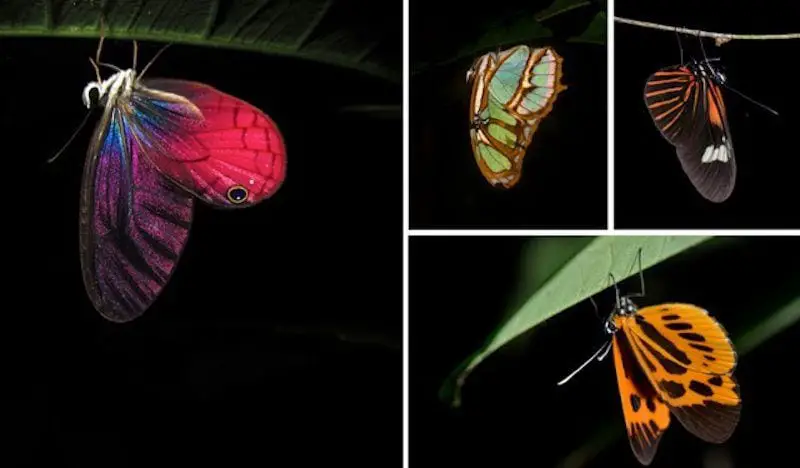Butterflies are some of the most beautiful and fascinating creatures on earth. Their colorful wings and delicate nature capture our imagination. But where do these winged insects go when the sun goes down? Understanding butterfly behavior at night reveals important insights into their life cycles.
Butterflies Rest at Night
Like most animals, butterflies need to rest at night. Their activity patterns follow circadian rhythms that synchronize with daylight hours. Butterflies spend nights resting to conserve energy and avoid nocturnal predators.
When resting, butterflies assume a motionless posture by folding their wings together above their bodies and anchoring themselves to vegetation. This protects the wings from damage. Butterflies may rest on leaves, stems, branches, rocks, or man-made structures.
Many butterflies rest underneath leaves or foliage to conceal themselves. Their cryptic underwing patterns camouflage them during rest. Butterflies may produce chemicals that act as antifeedants to deter predators. Their stillness makes them difficult to detect at night.
Butterfly Roosting Behavior
Some butterflies display communal roosting behavior at night by forming groups. For example, monarchs form massive clusters in trees during migration. Viceroys congregate in leks. Communal roosts may serve multiple functions:
| Function | Description |
|---|---|
| Thermoregulation | Huddling together preserves heat |
| Protection | Large groups detect predators earlier |
| Information transfer | Knowledge about food sources and migration is shared |
Not all butterflies roost communally. Many species rest solitarily, scattered across the landscape. Solitary resters include swallowtails, admirals, sulfurs, and skippers. Their night habits depend on species traits and environmental conditions.
Butterfly Overwintering Sites
Butterfly behavior at night also varies by season. During warm months, most butterflies are active during the day and rest at night. But when winter arrives, butterflies must seek protected overwintering sites to endure cold conditions until spring.
The types of overwintering sites used by butterflies include:
| Overwintering Site | Example Species |
|---|---|
| Cavities in trees, rocks, buildings | Mourning cloaks, eastern commas |
| Leaf litter and debris on forest floor | Ringlets, anglewings |
| Bark crevices | Hairstreaks, elfins |
By safely spending the winter in these shelters, butterflies conserve energy and survive extreme temperatures or storms. Their dormancy behaviors are fascinating adaptations.
Nocturnal Butterfly Species
While most butterflies are active during the daytime, some exceptional species have evolved to be nocturnal. These night-flying butterflies have adapted their senses and behaviors for a different niche. Examples of nocturnal species include:
| Species | Range |
|---|---|
| Brephidium exilis | Western North America |
| Caprona atra | India, Southeast Asia |
| Caligo spp. | Central and South America |
These butterflies take advantage of safer nighttime conditions to find mates, food and habitats. Their activity patterns demonstrate the diversity of butterfly lifestyles.
Butterfly Migration
One of the most impressive examples of nocturnal butterfly behavior is migration. To travel long distances, some famous migratory butterflies like monarchs and painted ladies fly during the day and rest during the night.
Monarchs form massive overnight roosts in tree groves along their migration routes. These roosts may contain millions of butterflies densely clustered together. In the morning, the monarchs resume flying south. The cycle repeats each night.
Nocturnal resting allows migratory butterflies to conserve energy on their long journeys. Their navigation skills help them locate suitable stopover sites each evening.
Metamorphosis Effects on Sleep Sites
The nighttime resting places used by butterflies depend on their developmental stage:
| Stage | Sleep Site |
|---|---|
| Egg | On host plant where laid |
| Caterpillar | On top of host plant, nestled in foliage |
| Pupa | Attached to a crevice or stem via silk |
| Adult | On vegetation, trees, man-made structures |
Young instars rest on or near their host plants. Caterpillars spin silk mats or tie leaves together to create sheltered nests. Pupae remain at their attachment sites. Adults fly to suitable resting spots each night.
Environmental Cues for Sleep
Butterflies rely on environmental cues like light, temperature, and time of day to establish proper sleep cycles. Photoreceptors in their eyes detect decreasing light levels at dusk. Cooler temperatures of nightfall also signal time for rest.
Circadian pacemakers synchronize butterfly nervous systems with Earth’s 24-hour day-night cycle. This maximizes activity at ideal times and ensures adequate rest. Proper sleep-wake cycles enable healthy development.
If environmental signals are disrupted, butterfly rhythms falter. Artificial night lighting can prevent full dormancy by mimicking daytime conditions. It also exposes resting butterflies to greater predation risks.
Threats to Butterflies at Night
While the darkness provides cover, nighttime still holds dangers for resting butterflies. Nocturnal predators like bats, owls, and spiders may hunt sleeping butterflies. Certain parasitic wasps also inject eggs into dormant caterpillars.
Adverse weather exposes roosting butterflies to severe risks. Major storms or cold snaps can decimate overwintering monarch colonies. Tree cover provides critical protection from heavy rains and winds.
Habitat loss also threatens essential overnight shelters. Deforestation removes vegetation needed by migrating monarchs for roosting. Urbanization destroys the microclimates where many butterflies spend the winter.
Conclusion
Butterflies exhibit fascinating behaviors shaped by evolutionary adaptations for survival. Their nighttime routines reveal important aspects of their life histories. Whether resting solitary or roosting communally, butterflies rely on suitable shelters to get them through the dangers of darkness.
Understanding nocturnal butterfly ecology enables better conservation. Protecting essential habitats both day and night allows these captivating insects to continue their extraordinary seasonal cycles. The hidden world of slumbering butterflies contains untold wonders still being discovered.


